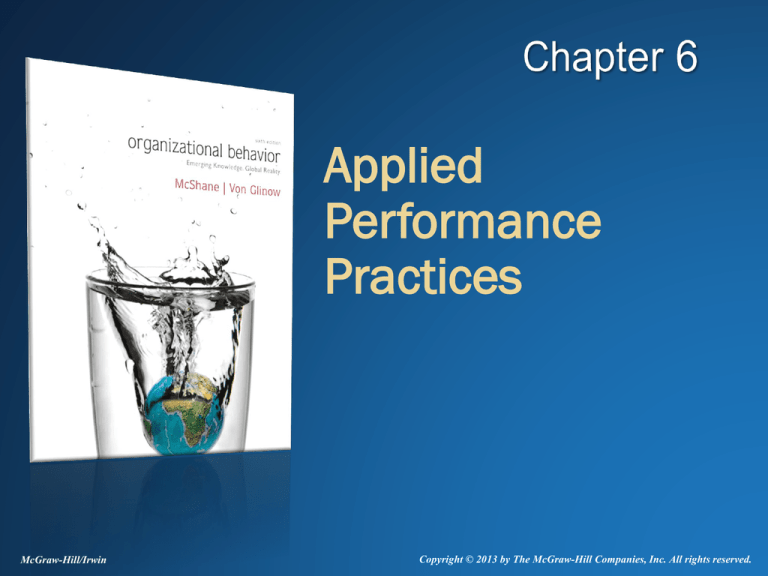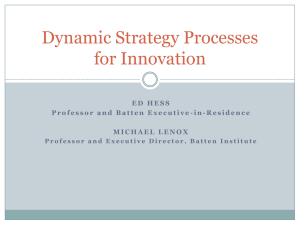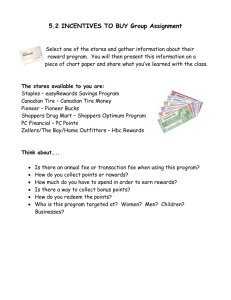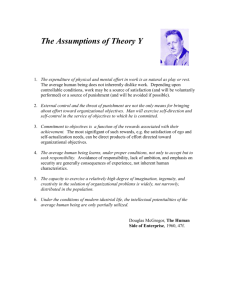
Applied
Performance
Practices
McGraw-Hill/Irwin
Copyright © 2013 by The McGraw-Hill Companies, Inc. All rights reserved.
Applied Performance Practices in
Chinese Factories
Most factory workers in China’s
Pearl River Delta are paid for the
number of units they produce.
The work is usually repetitive –
some jobs require several
thousand task cycles each day.
6-2
Meaning of Money in the Workplace
Money means different things
to people
• symbol of success
• reinforcer and motivator
• reflection of performance
• Source of less/more anxiety
Differences in meaning of
money by gender and culture
Money is an important
motivator
6-3
Membership/Seniority Based Rewards
Fixed wages, seniority increases
Advantages
• Guaranteed wages may attract job applicants
• Seniority-based rewards reduce turnover
Disadvantages
• Doesn’t motivate job performance
• Discourages poor performers from leaving
• May act as golden handcuffs (tie people to the job)
6-4
Job Status-Based Rewards
Includes job evaluation and status perks
Advantages:
• Job evaluation tries to maintain fairness
• Motivates competition for promotions
Disadvantages:
• Employees exaggerate duties, hoard resources
• Reinforces status
• Encourage hierarchy, might undermine cost-
efficiency and responsiveness
6-5
Competency-Based Rewards
Pay increases with competencies acquired
and demonstrated
Skill-based pay
• Pay increases with skill modules learned
Advantages
• More flexible work force, better quality,
consistent with employability
Disadvantages
• Potentially subjective, higher training costs
6-6
Organizational Rewards
Types of organizational rewards
• Organizational bonuses (e.g. company trips)
• Employee stock ownership plans (ESOPS)
• Stock options
• Profit-sharing plans
Evaluating organizational rewards
• Creates an “ownership culture”
• Adjusts pay with firm's prosperity
• Weak link between individual effort and rewards
• Rewards affected by external forces
6-7
Improving Reward Effectiveness
Link rewards to performance
Ensure rewards are relevant
Team rewards for interdependent jobs
Ensure rewards are valued
Watch out for unintended consequences
6-8
Unintended Consequences of
Rewards at TransSantiago
Transit bus drivers in Santiago,
Chile were paid by the number
of passengers
• Motivated starting work on time,
shorter breaks, efficient driving,
ensuring passengers paid fares
Unintended consequences
• Traffic accidents -- reckless driving to
next stop, cut off competing buses
• Passenger injuries/deaths – doors
left open, buses departed before all
on board
• Drove past stops with only one
passenger waiting
6-9
Job Design
Assigning tasks to a job,
including the interdependency
of those tasks with other jobs
Organization's goal -- to create
jobs that can be performed
efficiently yet employees are
motivated and engaged
6-10
Job Specialization
Dividing work into separate jobs, each with a subset
of tasks required to complete the product/service
Scientific management
• Frederick Winslow Taylor
• Champion of job specialization
• Taylor also emphasized person-job matching, training, goal
setting, work incentives
6-11
Evaluating Job Specialization
Advantages
Less time changing
activities
Lower training costs
Job mastered quickly
Better person-job
matching
Disadvantages
Job boredom
Discontentment pay
Higher costs
Lower quality
Lower motivation
6-12
Job Characteristics Model
Core Job
Characteristics
Critical
Psychological
States
Outcomes
Work
motivation
Skill variety
Task identity
Task significance
Meaningfulness
Autonomy
Responsibility
General
satisfaction
Feedback
from job
Knowledge
of results
Work
effectiveness
Growth
satisfaction
Individual
differences
6-13
Improving Task Significance
Through Voice of the Customer
Rolls Royce Engine Services
improved task significance
through their “Voice of the
Customer” program, in which
customers talk to production staff
about how the quality of their
engine maintenance work is
important to customers.
6-14
Job Rotation
Moving from one job to
another
Benefits
Job ‘A’
1. Minimizes repetitive strain
injury
2. Multiskills the workforce
3. Potentially reduces job
boredom
Job ‘B’
Job ‘D’
Job ‘C’
6-15
Job Enlargement
Adding tasks to an existing job
Example: video journalist
Traditional news team
Employee 1
Operates camera
Employee 2
Operates sound
Video journalist
• Operates camera
• Operates sound
• Reports story
Employee 3
Reports story
6-16
Job Enrichment
Given more responsibility for scheduling,
coordinating, and planning one’s own work
1. Clustering tasks into natural groups
• Stitching highly interdependent tasks into one job
• e.g., video journalist, assembling entire product
2. Establishing client relationships
• Directly responsible for specific clients
• Communicate directly with those clients
6-17
Dimensions of Empowerment
Selfdetermination
Employees feel they have
freedom and discretion
Meaning
Employees believe their work is
important
Competence
Employees have feelings of selfefficacy
Impact
Employees feel their actions
influence success
6-18
Supporting Empowerment
Individual factors
• Possess required competencies, able to perform
the work
Job design factors
• Autonomy, task identity, task significance, job
feedback
Organizational factors
• Resources, learning orientation, trust
6-19
Self-Leadership
The process of influencing oneself to establish the selfdirection and self-motivation needed to perform a task
Includes concepts/practices from goal setting, social
cognitive theory, and sports psychology
Self-leadership at
Bayer CropScience
6-20
Elements of Self-Leadership
Personal
Goal Setting
Constructive
Thought
Patterns
Designing
Natural
Rewards
SelfMonitoring
SelfReinforcement
Personal goal setting
Employees set their own goals
Apply effective goal setting practices
6-21
Elements of Self-Leadership
Personal
Goal Setting
Constructive
Thought
Patterns
Designing
Natural
Rewards
SelfMonitoring
SelfReinforcement
Positive self-talk
• Talking to ourselves about thoughts/actions
• Potentially increases self-efficacy
Mental imagery
• Mentally practicing a task
• Visualizing successful task completion
6-22
Elements of Self-Leadership
Personal
Goal Setting
Constructive
Thought
Patterns
Designing
Natural
Rewards
SelfMonitoring
SelfReinforcement
Finding ways to make the job itself more motivating
• e.g. altering the way the task is accomplished
6-23
Elements of Self-Leadership
Personal
Goal Setting
Constructive
Thought
Patterns
Designing
Natural
Rewards
SelfMonitoring
SelfReinforcement
Keeping track of your progress toward the self-set goal
• Looking for naturally-occurring feedback
• Designing artificial feedback
6-24
Elements of Self-Leadership
Personal
Goal Setting
Constructive
Thought
Patterns
Designing
Natural
Rewards
SelfMonitoring
SelfReinforcement
“Taking” a reinforcer only after completing a self-set goal
• e.g. Watching a movie after writing two more sections of a report
• e.g. Starting a fun task after completing a task that you don’t like
6-25
Self-Leadership Contingencies
Individual factors
• Higher levels of conscientiousness and
extroversion
• Positive self-evaluation (self-esteem, self-efficacy,
internal locus)
Organizational factors
• Job autonomy
• Participative and trustworthy leadership
• Measurement-oriented culture
6-26
Applied
Performance
Practices





